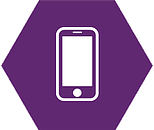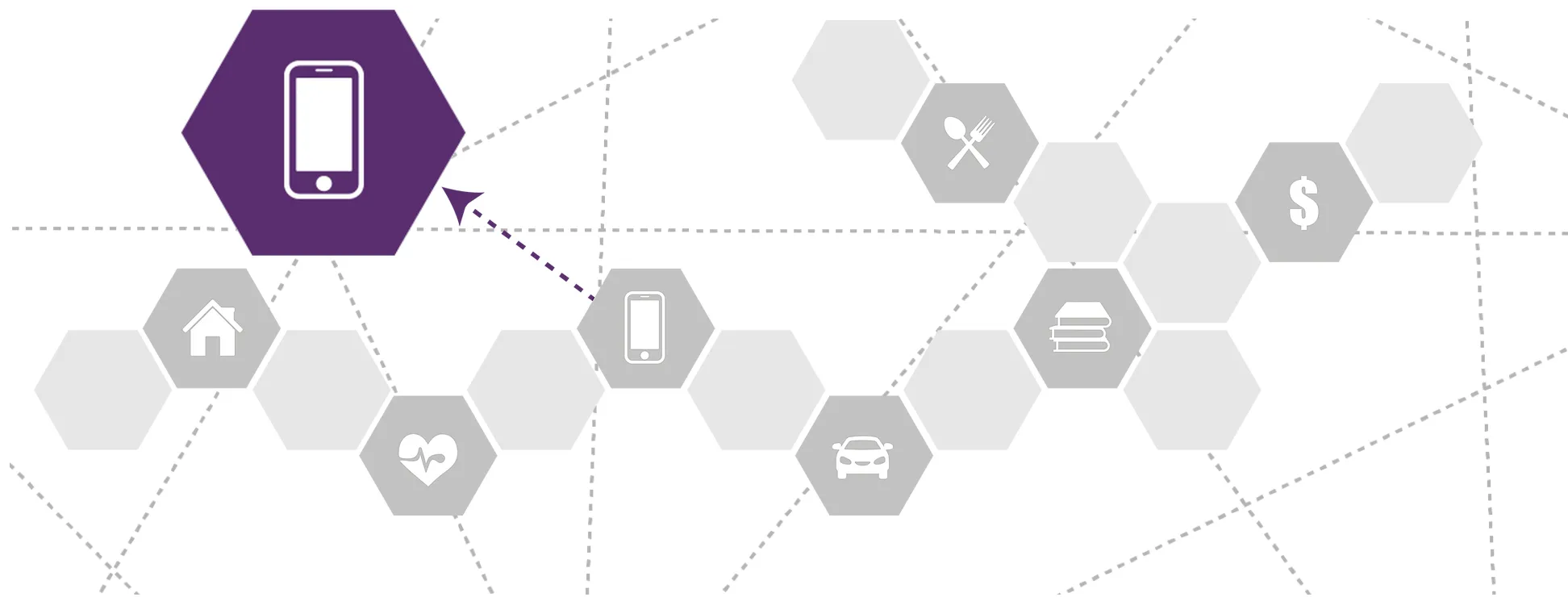
|
Housingclick to view |

|
Health Careclick to view |

|
Child Care and Educationclick to view |

|
Technologyclick to view |

|
Foodclick to view |

|
Taxesclick to view |

|
Transportationclick to view |
||
Impact on ALICE
What do families do if they don't have access to technology?
For many ALICE households, access to technology, or adequate technology, is not a given. These families may try to:
Pay More Than Budget Allows
One in five Americans are “smartphone-only” internet users (i.e., they own a smartphone, but do not have broadband internet service at home). This smartphone dependency has grown over time, from 8 percent of adults in 2013 to 20 percent of adults by 2018.15
Smartphone dependency impacts access to and use of the internet:
- Smartphone-only users are more likely to use their phone during a job search; 63 percent used their smartphone for job information, compared to 43 percent of all users; 39 percent used their smartphone to submit a job application, compared to 18 percent of all users.16
- Smartphone-only users are also less likely than other smartphone owners to use phones for; online shopping (36 percent vs. 66 percent); online banking or bill-paying (49 percent vs. 74 percent); and viewing local news (70 percent vs. 82 percent).17
- For children in smartphone-only households, 35 percent use the internet to look up topics they are interested in, compared to 77 percent of children with home internet access.18
Smartphone-only users vary by demographic group and are more likely to be younger, lower-income, or Black or Hispanic adults (2018 data):19
- Income level: 31 percent of adults who made less than $30,000 per year were smartphone dependent, compared with 9 percent of adults who made $75,000 or more per year.
- Race/ethnicity: 35 percent of Hispanic adults and 24 percent of Black adults were smartphone-dependent compared with 14 percent of White adults.
- Education: 39 percent of adults with less than a high school education are smartphone- dependent, compared with 22 percent of high school graduates, and 10 percent of college graduates.
- Rural/urban: 22 percent of urban dwellers and 17 percent of rural and suburban residents are smartphone-dependent.
One in five Americans are “smartphone-only” internet users (i.e., they own a smartphone, but do not have broadband internet service at home). This smartphone dependency has grown over time, from 8 percent of adults in 2013 to 20 percent of adults by 2018.15
Smartphone dependency impacts access to and use of the internet:
- Smartphone-only users are more likely to use their phone during a job search; 63 percent used their smartphone for job information, compared to 43 percent of all users; 39 percent used their smartphone to submit a job application, compared to 18 percent of all users.16
- Smartphone-only users are also less likely than other smartphone owners to use phones for; online shopping (36 percent vs. 66 percent); online banking or bill-paying (49 percent vs. 74 percent); and viewing local news (70 percent vs. 82 percent).17
- For children in smartphone-only households, 35 percent use the internet to look up topics they are interested in, compared to 77 percent of children with home internet access.18
Smartphone-only users vary by demographic group and are more likely to be younger, lower-income, or Black or Hispanic adults (2018 data):19
- Income level: 31 percent of adults who made less than $30,000 per year were smartphone dependent, compared with 9 percent of adults who made $75,000 or more per year.
- Race/ethnicity: 35 percent of Hispanic adults and 24 percent of Black adults were smartphone-dependent compared with 14 percent of White adults.
- Education: 39 percent of adults with less than a high school education are smartphone- dependent, compared with 22 percent of high school graduates, and 10 percent of college graduates.
- Rural/urban: 22 percent of urban dwellers and 17 percent of rural and suburban residents are smartphone-dependent.

Live in Less Desirable Locations
There are federal and state-specific programs available to help low-income households pay for phone and internet service. For example, the Lifeline Program, which is the primary federal program, provides discounted phone and internet services for eligible low-income consumers in every U.S. state, territory, commonwealth, and on Tribal lands.25
However, discounted programs are reaching very few eligible Americans: Only 6 percent of people with incomes below 185 percent of the Federal Poverty Level say they have signed up for a discounted service of any kind.26 For the Lifeline Program in particular, only 28 percent of eligible households were enrolled in 2017 (ranging from 4 percent in Wyoming to 47 percent in Alaska).27
In addition to subsidized plans, there are some relatively inexpensive cellphone plans available through a variety of providers (with monthly payments as low as $10/month); however, these plans often require users to buy their own phones, which can add substantial cost.
There are federal and state-specific programs available to help low-income households pay for phone and internet service. For example, the Lifeline Program, which is the primary federal program, provides discounted phone and internet services for eligible low-income consumers in every U.S. state, territory, commonwealth, and on Tribal lands.25
However, discounted programs are reaching very few eligible Americans: Only 6 percent of people with incomes below 185 percent of the Federal Poverty Level say they have signed up for a discounted service of any kind.26 For the Lifeline Program in particular, only 28 percent of eligible households were enrolled in 2017 (ranging from 4 percent in Wyoming to 47 percent in Alaska).27
In addition to subsidized plans, there are some relatively inexpensive cellphone plans available through a variety of providers (with monthly payments as low as $10/month); however, these plans often require users to buy their own phones, which can add substantial cost.

Reduce Other Expenditures
Ninety percent of people surveyed in 2016 said they have used public internet for a variety of reasons, including checking email (58 percent), accessing social media (56 percent), and online banking (22 percent).33 Many Americans rely on public internet access, either in the form of shared computers at locations such as schools and libraries, or through use of their own devices (smartphones, computers, tablets) connected to free or paid public internet (hotspots).
Ninety percent of people surveyed in 2016 said they have used public internet for a variety of reasons, including checking email (58 percent), accessing social media (56 percent), and online banking (22 percent).33 Many Americans rely on public internet access, either in the form of shared computers at locations such as schools and libraries, or through use of their own devices (smartphones, computers, tablets) connected to free or paid public internet (hotspots).
In 2016, 29 percent of people reported visiting libraries to use computers or access Wi-Fi. The majority of people who use tech resources at a library do so for research for work or school (61 percent), followed by checking emails or texts (53 percent), looking for health information (38 percent), or taking an online class or certification (26 percent).34
Twelve percent of teens say they at least sometimes use public Wi-Fi to complete assignments because they do not have an internet connection at home; this is more common among low-income students and teens of color.35
In 2016, 29 percent of people reported visiting libraries to use computers or access Wi-Fi. The majority of people who use tech resources at a library do so for research for work or school (61 percent), followed by checking emails or texts (53 percent), looking for health information (38 percent), or taking an online class or certification (26 percent).34
Twelve percent of teens say they at least sometimes use public Wi-Fi to complete assignments because they do not have an internet connection at home; this is more common among low-income students and teens of color.35

Sources
15
Pew Research Center. (2019, June 12). Mobile fact sheet. Retrieved from https://www.pewinternet.org/fact-sheet/mobile/
16
Smith, A. (2015, April 1). Chapter two: U.S. smartphone use in 2015. Pew Research Center. Retrieved from https://www.pewinternet.org/2015/04/01/chapter-two-usage-and-attitudes-toward-smartphones/#job%20seeking
17
Smith, A. (2015, April 1). Chapter two: U.S. smartphone use in 2015. Pew Research Center. Retrieved from https://www.pewinternet.org/2015/04/01/chapter-two-usage-and-attitudes-toward-smartphones/#job%20seeking
18
Rideout, V., & Katz, V. (2016, Winter). Opportunity for all? Technology and learning in lower-income families. A report of the families and media project. The Joan Ganz Cooney Center at Sesame Workshop. Retrieved from http://joanganzcooneycenter.org/wp-content/uploads/2016/01/jgcc_opportunityforall.pdf
19
Pew Research Center. (2019, June 12). Mobile fact sheet. Retrieved from https://www.pewinternet.org/fact-sheet/mobile/ Ryan, C. (2018, August). Computer and internet use in the United States: 2016. American Community Survey Reports, U.S. Census Bureau. Retrieved from https://www.census.gov/content/dam/Census/library/publications/2018/acs/ACS-39.pdf
20
Anderson, M. (2018, September 10). About a quarter of rural Americans say access to high-speed internet is a major problem. Pew Research Center. Retrieved from https://www.pewresearch.org/fact-tank/2018/09/10/about-a-quarter-of-rural-americans-say-access-to-high-speed-internet-is-a-major-problem/
21
Anderson, M., & Perrin, A. (2018, October 26). Nearly one-in-five teens can’t always finish their homework because of the digital divide. Retrieved from https://www.pewresearch.org/fact-tank/2018/10/26/nearly-one-in-five-teens-cant-always-finish-their-homework-because-of-the-digital-divide/
22
Bencie, L. (2017, May 3). Why you really need to stop using public Wi-Fi. Harvard Business Review. Retrieved from https://hbr.org/2017/05/why-you-really-need-to-stop-using-public-wi-fi
23
Adepu, S., & Adler, R. F. (2016, October). A comparison of performance and preference on mobile devices vs. desktop computers. 2016 IEEE 7th Annual Ubiquitous Computing, Electronics & Mobile Communication Conference (UEMCON), 1–7. Retrieved from https://ieeexplore.ieee.org/document/7777808
24
eMarketer. (2015, February 5). Only 33% of US mobile users will pay for apps this year. Retrieved from https://www.emarketer.com/Article/Only-33-of-US-Mobile-Users-Will-Pay-Apps-This-Year/1011965
25
Federal Communications Commission. (2019). Lifeline program for low-income consumers. Retrieved from https://www.fcc.gov/general/lifeline-program-low-income-consumers
26
Rideout, V., & Katz, V. (2016, Winter). Opportunity for all? Technology and learning in lower-income families. A report of the families and media project. The Joan Ganz Cooney Center at Sesame Workshop. Retrieved from http://joanganzcooneycenter.org/wp-content/uploads/2016/01/jgcc_opportunityforall.pdf
27
Universal Service Administrative Co. (2019). Lifeline participation. Retrieved from https://www.usac.org/li/about/process-overview/stats/participation.aspx
28
Burton, M., & Mayo, J. W. (2005, March). Understanding participation in social programs: Why don’t households pick up the lifeline? McDonough School of Business. Retrieved from https://bear.warrington.ufl.edu/centers/purc/docs/papers/LIFELINE/0206/0305_Burton_Mayo_Understanding_Participation_in.pdf
29
Universal Service Administrative Co. (2019). Lifeline: Get connected. Retrieved from https://www.lifelinesupport.org/ls/default.aspx
30
Consumer Reports. (2019, May 23). Best low-cost cell-phone plans. B. Fowler, Author. Retrieved from https://www.consumerreports.org/u-s-cell-phone-carriers/best-cell-phone-plans-save-money/
Consumer Reports. (2018, May 26). How to save money with a cheap cell-phone service. B. Fowler, Author. Retrieved from https://www.consumerreports.org/smartphones/how-to-save-money-with-cheap-cell-phone-service/
31
Rideout, V., & Katz, V. (2016, Winter). Opportunity for all? Technology and learning in lower-income families. A report of the families and media project. The Joan Ganz Cooney Center at Sesame Workshop. Retrieved from http://joanganzcooneycenter.org/wp-content/uploads/2016/01/jgcc_opportunityforall.pdf
Consumer Reports. (2019, May 23). Best low-cost cell-phone plans. B. Fowler, Author. Retrieved from https://www.consumerreports.org/u-s-cell-phone-carriers/best-cell-phone-plans-save-money/
Consumer Reports. (2018, May 26). How to save money with a cheap cell-phone service. B. Fowler, Author. Retrieved from https://www.consumerreports.org/smartphones/how-to-save-money-with-cheap-cell-phone-service/
32
Consumer Reports. (2019, March 8). Best deals on the Samsung Galaxy S10, S10+, and S10e. B. Fowler, Author. Retrieved from https://www.consumerreports.org/smartphones/best-deals-on-samsung-galaxy-s10-smartphone/
33
Pew Research Center. (2019, June 12). Mobile fact sheet. Retrieved from https://www.pewinternet.org/fact-sheet/mobile/
34
Horrigan, J. B. (2016, September 9). 2. Library usage and engagement. Pew Research Center. Retrieved from https://www.pewinternet.org/2016/09/09/library-usage-and-engagement/
35
Anderson, M., & Perrin, A. (2018, October 26). Nearly one-in-five teens can’t always finish their homework because of the digital divide. Retrieved from https://www.pewresearch.org/fact-tank/2018/10/26/nearly-one-in-five-teens-cant-always-finish-their-homework-because-of-the-digital-divide/
36
Horrigan, J. B. (2016, September 9). 2. Library usage and engagement. Pew Research Center. Retrieved from https://www.pewinternet.org/2016/09/09/library-usage-and-engagement/
37
Pew Research Center. (2019, June 12). Mobile fact sheet. Retrieved from https://www.pewinternet.org/fact-sheet/mobile/
Bencie, L. (2017, May 3). Why you really need to stop using public Wi-Fi. Harvard Business Review. Retrieved from https://hbr.org/2017/05/why-you-really-need-to-stop-using-public-wi-fi
Madden, M., Gilman, M., Levy, K., & Marwick, A. (2017). Privacy, poverty, and big data: A matrix of vulnerabilities for poor Americans. Washington Unviersity Law Review, 95(1), 53–125. Retrieved from https://openscholarship.wustl.edu/cgi/viewcontent.cgi?article=6265&context=law_lawreview
Internet Essentials From Comcast. (n.d.). Online safety and security. Retrieved from https://internetessentials.com/en/learning/OnlineSafetyandSecurity
Gilman, M. E. (2012). The class differential in privacy law. Brooklyn Law Review, 77(4), 1389–1445. Retrieved from https://brooklynworks.brooklaw.edu/cgi/viewcontent.cgi?referer=&httpsredir=1&article=1140&context=blr
38
Pew Research Center. (2014, July 9). Public libraries and technology: From “houses of knowledge” to “houses of access.” Retrieved from https://www.pewinternet.org/2014/07/09/public-libraries-and-technology-from-houses-of-knowledge-to-houses-of-access/

